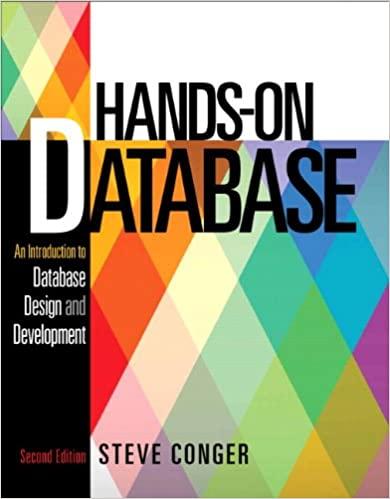Question
Each Expr is an expression using ONLY the following: 1. Integer constants 0 through 255 (0xFF), inclusive. You are not allowed to use big constants
Each "Expr" is an expression using ONLY the following:
1. Integer constants 0 through 255 (0xFF), inclusive. You are not allowed to use big constants such as 0xffffffff.
2. Function arguments and local variables (no global variables).
3. Unary integer operations ! ~
4. Binary integer operations & ^ | + << >> Some of the problems restrict the set of allowed operators even further. Each "Expr" may consist of multiple operators. You are not restricted to one operator per line.
You are expressly forbidden to:
1. Use any control constructs such as if, do, while, for, switch, etc.
2. Define or use any macros.
3.Define any additional functions in this file.
4. Call any functions.
5. Use any other operations, such as &&, ||, -, or ?:
6. Use any form of casting.
7. Use any data type other than int. This implies that you cannot use arrays, structs, or unions.
you may assume that your machine: 1. Uses 2s complement, 32-bit representations of integers. 2. Performs right shifts arithmetically. 3. Has unpredictable behavior when shifting an integer by more than the word size.
EXAMPLES OF ACCEPTABLE CODING STYLE:
/* * pow2plus1 - returns 2^x + 1, where 0 <= x <= 31 */ int pow2plus1(int x) { /* exploit ability of shifts to compute powers of 2 */ return (1 << x) + 1; }
/* * pow2plus4 - returns 2^x + 4, where 0 <= x <= 31 */ int pow2plus4(int x) { /* exploit ability of shifts to compute powers of 2 */ int result = (1 << x); result += 4; return result; }
Q:
* anyOddBit - return 1 if any odd-numbered bit in word set to 1 * Examples anyOddBit(0x5) = 0, anyOddBit(0x7) = 1 * Legal ops: ! ~ & ^ | + << >> * Max ops: 12 */ int anyOddBit(int x) {
}
/* howManyBits - return the minimum number of bits required to represent x in * two's complement * Examples: howManyBits(12) = 5 * howManyBits(298) = 10 * howManyBits(-5) = 4 * howManyBits(0) = 1 * howManyBits(-1) = 1 * howManyBits(0x80000000) = 32 * Legal ops: ! ~ & ^ | + << >> * Max ops: 90 */ int howManyBits(int x) { return 2; } /* * isNonZero - Check whether x is nonzero using * the legal operators except ! * Examples: isNonZero(3) = 1, isNonZero(0) = 0 * Legal ops: ~ & ^ | + << >> * Max ops: 10 */ int isNonZero(int x) { return 2; } /* * absVal - absolute value of x * Example: absVal(-1) = 1. * You may assume -TMax <= x <= TMax * Legal ops: ! ~ & ^ | + << >> * Max ops: 10 */ int absVal(int x) { return 2; } /*
Step by Step Solution
There are 3 Steps involved in it
Step: 1

Get Instant Access to Expert-Tailored Solutions
See step-by-step solutions with expert insights and AI powered tools for academic success
Step: 2

Step: 3

Ace Your Homework with AI
Get the answers you need in no time with our AI-driven, step-by-step assistance
Get Started


